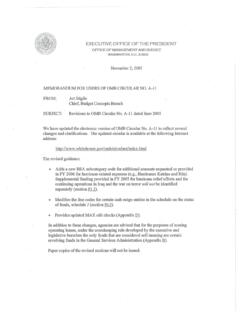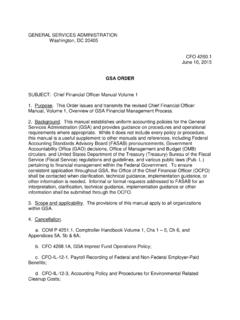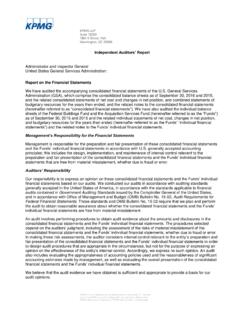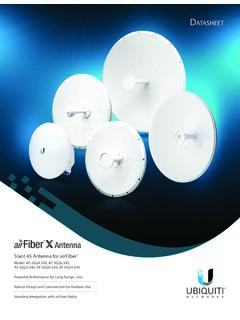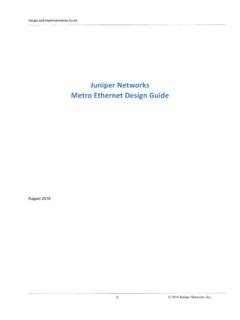Transcription of SD -WAN OVERVIEW AND ORDERING GUIDE Enterprise ...
1 Enterprise Infrastructure Solutions (EIS) SD-WAN OVERVIEW and ORDERING GUIDE Issued by: General Services Administration Office of Telecommunications Services 1800 F St NW Washington, DC 20405 Version August 2020 SD-WAN OVERVIEW AND ORDERING GUIDE Page i Table of Contents 1 Introduction .. 1 2 OVERVIEW of SD-WAN Technology .. 3 Defining Characteristics of 4 SD-WAN Reference Architecture .. 6 3 Why SD-WAN? .. 8 Market Drivers for SD-WAN 8 SD-WAN Benefits and Risks .. 9 Examples of How SD-WAN Could be Used .. 11 4 Is SD-WAN Right for You? A Checklist for Initial Evaluation .. 13 5 SD-WAN Implementation .. 15 Is DIY or Managed Service the Best Fit for Your Agency? .. 15 The Co-Management Option .. 18 Use Case 1: Managed SD-WAN with Hybrid MPLS and Internet Underlay.
2 18 Use Case 2: SD-WAN with Secure Connectivity to Cloud Services .. 20 Use Case 3: SD-WAN to Connect MPLS to Off-Net Sites Using Internet .. 21 6 Key Technical Specifications .. 22 7 Pricing Basics for SD-WAN .. 24 Managed Service: SDWANS Pricing Components .. 24 Task Order Unique CLINs .. 25 EIS Services Used in Conjunction with SDWANS .. 25 Access 25 Data Transport .. 26 Service Related Equipment .. 26 DIY SD-WAN: Pricing Components .. 26 EIS Services Used in Conjunction with SD-WAN: Pricing .. 27 Access 28 Data Transport Services .. 28 Equipment and Labor .. 29 8 References and Other Sources of Information .. 30 SD-WAN OVERVIEW and ORDERING GUIDE Page ii Figures Figure 1: Illustrative SD-WAN Deployment .. 4 Figure 2: SD-WAN Reference Architecture.
3 6 Figure 3: Hybrid SD-WAN (MPLS plus Internet) .. 19 Figure 4: SD-WAN Establishing Secure Cloud 20 Figure 5: SD-WAN Connecting MPLS to Off-Net Sites Using 21 Figure 6: How Total Charges for SDWANS are Calculated .. 24 Figure 7: Pricing for the EIS Managed Offering, Figure 8: Pricing for DIY Figure 9: Pricing Components for DIY Tables Table 1: Checklist for Agency Consideration of SD-WAN Adoption .. 13 Table 2: Comparison of DIY vs. Managed Options for SD-WAN Solutions .. 15 Table 3: Checklist for Agency Consideration of DIY vs. Managed SD-WAN .. 16 Table 4: SD-WAN Technical Capabilities .. 22 Table 5: SDWANS Pricing Components .. 24 Page 1 1 Introduction This SD-WAN OVERVIEW and ORDERING GUIDE ( GUIDE ) is intended to assist Federal agency telecommunications customers seeking to implement Software-Defined Wide Area Network ( SD-WAN ) technologies under Enterprise Infrastructure Solutions ( EIS ) contract task orders.
4 The primary target audience of the GUIDE is Federal agency customers considering whether and how to incorporate SD-WAN into their telecommunications networks. This GUIDE incorporates information from the industry s first voluntary SD-WAN standard SD-WAN Service Attributes and Services (MEF 70) published by the MEF Forum in July 2019 (hereafter MEF 70 ). SD-WAN is a virtual WAN network architecture that utilizes various data transport technologies and a centralized control function to securely and intelligently connect users to applications. Unlike traditional WAN, SD-WAN de-couples the transport service1 from its applications and software control function,2 resulting in a more agile, reliable and cost-effective network architecture. Because the software control operates as a separate plane from the underlying network transport functions, SD-WAN acts as an overlay network to monitor, manage, and optimize the use of that transport.
5 Regarding data transport, SD-WAN permits a Federal agency to combine and integrate multiple data transport technologies which can include Multiprotocol Label Switching ( MPLS ), carrier Ethernet ( CE ), public Internet, fixed and mobile wireless, and satellite-based services. Regarding the applications and control function, SD-WAN relies on pervasive software control working in concert with intelligent network edge devices to provide network-wide dynamic traffic routing and prioritization functionality, policy-setting capabilities, and quicker more efficient network deployments and configurations. Certain market drivers are pushing enterprises to adopt SD-WAN, including the following: 1) High-cost legacy networks (most frequently, MPLS-based) that aren t keeping pace with dramatically rising bandwidth demands, particularly from video and cloud-based Software as a Service ( SaaS ) and Network-as-a-Service ( Naas ) applications; 2) Inflexibility and/or poor quality of service ( QoS ) from legacy networks and the need to have more centralized network monitoring and management capabilities; 3) Expense and inefficiency caused by backhaul of traffic from branch/remote locations to headquarters or centralized data centers, often to meet cybersecurity requirements.
6 And 4) Overcoming cybersecurity vulnerabilities/challenges that have made the traditional perimeter network defense strategy inadequate. 1 The WAN transport service is commonly referred to as the data forwarding plane. 2 The applications and control function is commonly referred to as the control plane. SD-WAN OVERVIEW AND ORDERING GUIDE SD-WAN OVERVIEW and ORDERING GUIDE Page 2 Key findings and conclusions set forth in this GUIDE include: SD-WAN is a major advance in wide-area networking, that nearly every Federal agency will need to consider adopting and most will eventually find to be a compelling option. SD-WAN is ideal for a Federal agency looking to rely more heavily on cloud-based applications, while avoiding the expense and quality concerns associated with backhauling data through a centralized data center.
7 SD-WAN allows for more integrated, in-depth cybersecurity that can meet evolving Federal security requirements if properly implemented and continually monitored. A Federal Agency may want to evaluate whether a Managed Service option or Do-It Yourself ( DIY ) option best meets its needs, by evaluating the agency s IT resources and the complexity of its networking needs. Some Federal agencies may find that a Co-Managed SD-WAN provides the optimum balance, by leaving management of the basic infrastructure to the service provider but retaining hands-on control of key functions such as setting network policies, allocating bandwidth, and turning up new branch offices and other remote sites. Currently, SD-WAN is a Managed Service under the EIS Contract.
8 See, EIS Contract Sections and (SDWANS). Category: Managed Services. Complementary Services Needed: In order to use SDWANS, the agency would need EIS Transport services, such as VPNS, ETS, IPS, and Broadband Internet Service ( BIS ) provided by SDWANs. Definitions: Please see the EIS Acroynyms and Abbreviations and the EIS Glossary for clarification of terms and acronyms used in this document. See also, MEF 70, Section 3, Terminology and Abbreviations. SD-WAN OVERVIEW and ORDERING GUIDE Page 3 2 OVERVIEW of SD-WAN Technology A Wide Area Network (WAN) is a communications network that spans a large geographic region and connects networks/users in one location to networks/users in other locations. Traditionally, WANs often have been implemented using a private high-speed network in a hub and spoke architecture with data centers at the hub(s) and the spokes extending to branch offices and other user locations (which can be tens, hundreds, or thousands of miles from a hub).
9 Notably, traditional WANS will often apply cybersecurity tools at a central hub, thus necessitating backhaul of all traffic into that hub for verification prior to reaching its final destination. Most of the network control in a traditional WAN is decentralized, with routers at each node independently making decisions about their traffic from a local perspective. These WAN networks were originally designed to support relatively predictable and unvarying telecommunications requirements, and have worked well (or at least adequately, in most cases) for that purpose. However, traditional WAN networks are becoming increasingly unsuited for keeping up with today s highly dynamic demands for bandwidth and connectivity, driven by video, mobile data, and other data-intensive and cloud-based SD-WAN is now seen throughout the industry as a key technology, along with cloud-based applications and infrastructure, for enterprises to modernize their networks and keep pace with the telecommunications demands of their workforce and external clients.
10 However, SD-WAN is still an evolving and fluid technology, and its standardization is a work-in-progress. The best available industry source for a SD-WAN standard is MEF 70, recently issued in July 2019,4 the industry s first version of an SD-WAN service definition MEF 70 contains the following diagram of an SD-WAN network architecture. 3 For example, CTIA reports that wireless mobile data grew by 82% in just one year (2018), and has increased 73-fold since 2010. See CTIA 2019 Annual Survey Highlights, . 4 See MEF describes itself therein as an industry association of 200+ member companies, MEF is the driving force enabling agile, assured, and orchestrated communication services that empower users with the dynamic performance and security required to thrive in the digital economy.




